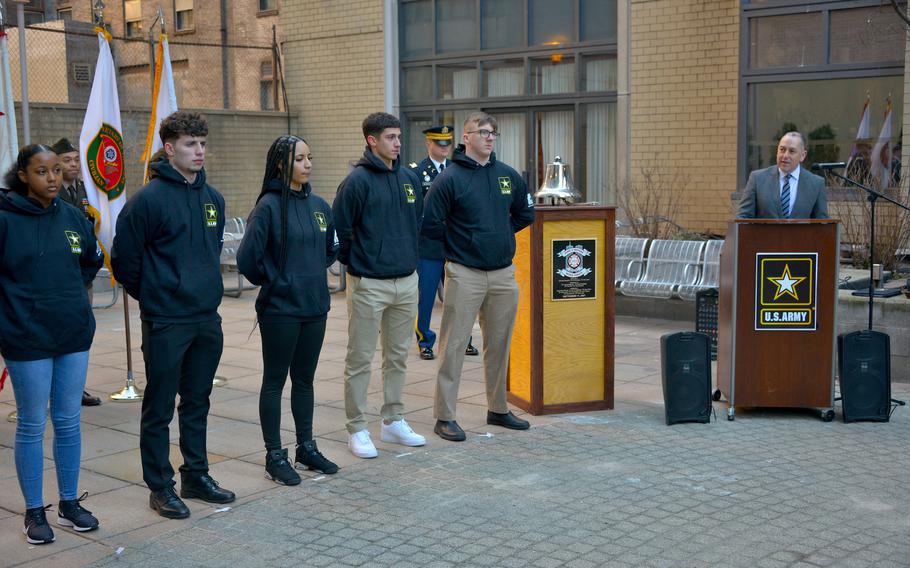
Undersecretary of the Army Gabriel Camarillo delivers the keynote address during a U.S. Army National Signing Day event on Feb. 14, 2023, in New York. (Gregory Williams/U.S. Army)
WASHINGTON — The Army is looking to significantly expand its advertising and marketing campaigns and make other moves to find as many new soldiers as possible, as it aims for a lofty recruiting target this year and a foundation for the years to come, a top service official said Tuesday.
Like all branches of the U.S. armed forces, the Army has faced substantial recruiting challenges in recent years. Last year, it was about 15,000 new recruits shy of its goal of 60,000. This year, the Army’s goal is 65,000 new soldiers.
“It’s become a whole-of-Army approach,” Undersecretary of the Army Gabriel Camarillo said Tuesday said during an interview at an Association of the United States Army event near Washington. “There is no part of the Army that isn’t actively engaged in confronting the recruiting challenge.”
Military recruiting has become more difficult in the modern age with an all-volunteer force for a variety of reasons, and the problem is high on the priority list for the Army, Navy, Air Force, Marines and Space Force.
The Army’s advertising efforts have already been apparent on television. The service resurrected its “Be All You Can Be” slogan earlier this year, rebranded with a new logo, bought ad times during the NCAA basketball tournament and ran slick new commercials during the games.
Camarillo said on Tuesday those moves are just part of the Army’s plans to cultivate a relationship with young Americans.
“Really, every senior leader in the Army spends every single week working on this challenge,” he noted. “[There are] a lot of levers we are pulling.”
The Army, in fact, is going well beyond traditional marketing to reach new recruits. It’s recently launched a Future Soldier Prep Course to expand the candidate pool, it has a referral program that offers promotion points or a new ribbon and the service is offering incentives to new soldiers, such as their choice of station after they complete basic training.
“These are just a few of the levers we are pulling,” Camarillo said. “There are many, many more.”
Camarillo noted that the Army’s requested budget for fiscal 2024 — roughly $185.5 billion — includes funding for all its recruiting plans.
One goal that’s part of the recruiting plan, the undersecretary added, is fine-tuning the messaging to Generation Z — Americans born from the mid-1990s to the mid-2010s — and introducing them to “the new United States Army.”
“The broader issue is how do we connect with Generation Z?” Camarillo asked at the AUSA event Tuesday. “The influencers for Generation Z — parents, grandparents, aunts and uncles, teachers, principals, guidance counselors — they understand the value of a career in the Army … and we have to reintroduce that.”
“They want community. They want purpose. They want what they’re doing to matter,” Army Secretary Christine Wormuth said of Generation Z Americans during an event last November. “I think we really need to reintroduce the Army to the country, to young people, to their parents, to influencers.”
According to recent Pentagon data, only 23% of young Americans between 17 and 24 meet the academic and physical requirements to serve in the military. Another study showed that fewer than 10% of young Americans are even interested in a military career. The sagging data have led the Army, the biggest armed service, to take a much more targeted approach to recruiting. That means narrower focus and just being more surgical in how and where it spends resources.
In other words, the Army is taking more of a sabermetric-style approach than it ever has before.
“We are looking at, how do we identify talented soldiers to serve as recruiters? How are we placing them in markets where they have backgrounds and areas of expertise? All of those kinds of things are in the works right now,” Camarillo said. “It’s hard to tell how it’s going to land, but the important thing is we are doing everything we possibly can.”
“This is not a one-year or two-year challenge,” he added. “This is a convergence of some near-term factors and some really long-term structural factors that are going to affect our ability to recruit for some time.”
Another avenue that the Army wants to follow, Army Chief of Staff Gen. James McConville said a few weeks ago, is finding recruits in families that don’t have a lot of military connections. More than 80% of recruits traditionally come from military families, he said.
“We really need to make it not a military family business — but an American family business,” McConville said at the time.
The Army’s ramped-up advertising campaign took a bit of a hit last month when the ads’ star, Jonathan Majors, 33, was arrested in New York City and charged with assaulting a woman. The actor, who’s appeared in major Hollywood motion pictures such as Creed III and Devotion, has denied the charges — but the Army pulled his commercials pending the outcome of a police investigation. The service spun some new ads together — instead featuring Army leaders such as Wormuth and McConville — and ran them during the Final Four.